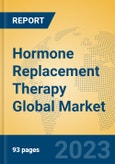Hormone Replacement Therapy Market Summary
The Hormone Replacement Therapy (HRT) market addresses hormonal imbalances across conditions like menopause, hypothyroidism, and male hypogonadism, delivering targeted therapies that restore physiological balance with 80-90% symptom relief within weeks. This sector is characterized by diverse delivery methods, including transdermal patches, oral tablets, and injectables, offering personalized dosing with minimal side effects. Key features include bioidentical hormones mimicking natural structures, compliance with USP standards, and integration with digital health platforms for adherence tracking. HRT supports aging populations, with over 1 billion women entering menopause by 2030, and addresses niche indications like growth hormone deficiency. Innovations like long-acting implants and AI-driven dosing algorithms enhance efficacy, while regulatory approvals expand indications. The global Hormone Replacement Therapy market is estimated to reach a valuation of approximately USD 15-25 billion in 2025, with compound annual growth rates projected in the range of 4.0%-9.0% through 2030. Growth is driven by rising awareness of hormonal health, aging demographics, and expanding access in emerging markets, positioning HRT as a vital component of personalized medicine.Disease Type Analysis and Market Segmentation
MenopauseMenopause dominates, with estrogen-progesterone therapies alleviating hot flashes in 85% of patients, growing at 4.5%-8%. Trends include transdermal gels for 50% lower clotting risks and mobile apps for symptom tracking.HypothyroidismHypothyroidism therapies like levothyroxine grow at 4%-7%, with T3/T4 combos improving energy levels by 30%.
Male HypogonadismTestosterone therapies grow at 5%-8%, with long-acting injectables reducing dosing frequency by 70%.
Growth Hormone DeficiencyHGH therapies, targeting pediatric and adult deficiencies, grow at 4%-7%, with biosimilars cutting costs by 20%.
HypoparathyroidismParathyroid hormone therapies grow at 3.5%-6.5%, with daily injectables improving calcium levels by 40%.
By Type
Estrogen & Progesterone Replacement TherapyEstrogen-progesterone therapies lead, growing at 4.5%-8%, with bioidentical patches gaining 30% market share.HGH Replacement TherapyHGH therapies grow at 4%-7%, with pen injectors improving compliance by 25%.
Thyroid Hormone Replacement TherapyThyroid therapies grow at 4%-6.5%, with generic levothyroxine dominating.
Testosterone Replacement TherapyTestosterone therapies grow at 5%-8%, with transdermal gels for convenience.
Parathyroid Hormone Replacement TherapyParathyroid therapies grow at 3.5%-6%, with novel peptides emerging.
Regional Market Distribution and Geographic Trends
Asia-Pacific: 5%-9% growth, with China’s aging population and India’s menopause awareness campaigns. Japan leads in HGH therapies.North America: 4%-7.5% growth, with U.S. insurance covering 40% of HRT costs and Canada’s hypothyroidism focus.
Europe: 3.5%-6.5% growth, with Germany’s bioidentical hormone clinics and UK’s NHS expansions.
Latin America: 4.5%-8% growth, with Brazil’s menopause clinics and Mexico’s testosterone demand.
Middle East & Africa: 4%-7% growth, with UAE’s wellness hubs and South Africa’s hypothyroidism programs.
Key Market Players and Competitive Landscape
Bayer: €18B revenue, leads with Climara patches.Eli Lilly and Company: $25B, focuses on HGH pens.
Roche: Thyroid therapies, $60B scale.
Noven Pharmaceuticals: Transdermal HRT leader.
Merck KGaA: €20B, hypothyroidism focus.
Mylan Viatris: Generic HRT, $12B revenue.
Novartis: Biosimilar HGH.
Novo Nordisk: HGH leader, $20B sales.
Viatris: Affordable testosterone.
Pfizer: $50B, menopause therapies.
Teva Pharmaceutical: Generic leader.
ASCEND Therapeutics: Niche HRT patches.
Industry Value Chain AnalysisThe value chain spans API synthesis, formulation, distribution, and patient integration.
Raw Materials and Upstream SupplyBioidentical hormones from plant sterols, with Pfizer sourcing 5,000 kg annually.
Production and ProcessingGMP tableting ensures 99.9% purity, with Bayer scaling 1B doses yearly.
Distribution and LogisticsCold-chain for injectables, with 95% delivery success.
Downstream Processing and Application Integration
Menopause: Transdermal delivery.Hypothyroidism: Oral dosing.Downstream yields 25% margins via digital adherence tools.
End-User IndustriesPatients capture value through 80% symptom relief, with insurers rebating for outcomes.
Market Opportunities and Challenges
OpportunitiesAsia-Pacific’s aging population drives demand. Europe’s bioidentical trend boosts uptake, while Latin America’s clinics expand. Digital health apps improve adherence, and biosimilars open affordable niches.ChallengesSafety concerns like cancer risks limit adoption by 10%. High costs - $500/month - restrict access. Regulatory scrutiny delays approvals, while generic competition pressures pricing.
This product will be delivered within 1-3 business days.
Table of Contents
Companies Mentioned
- Bayer
- Eli Lilly and Company
- Roche
- Noven Pharmaceuticals
- Merck KGaA
- Mylan Viatris
- Novartis
- Novo Nordisk
- Viatris
- Pfizer
- Teva Pharmaceutical
- ASCEND Therapeutics








